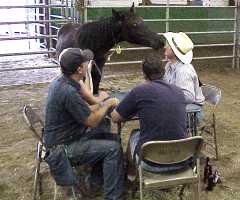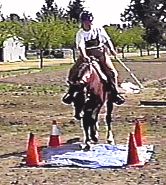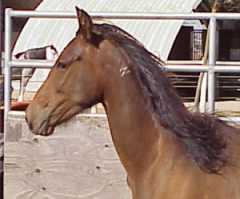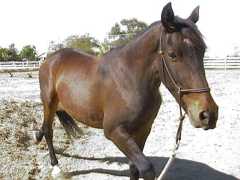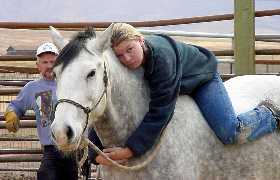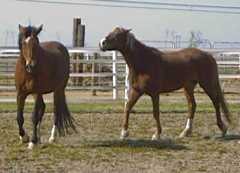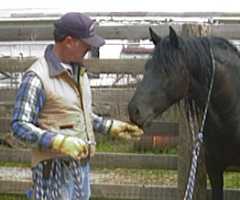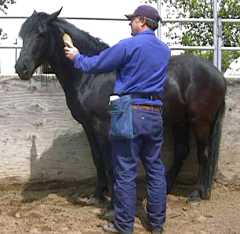KBR Equestrian Safety Series"SAFETY AROUND HORSES"
| ||||||||||||||||
| HORSE - HUMAN INTERACTION |
|
Unbridled Curiosity
Horses are naturally curious and tend to investigate their environment. They have an amazing ability to enter into situations that we may consider unlikely. However so long as those situations don't appear threatening in the mind of the horse, he will usually engage willingly. Understanding how a horse is naturally programmed to respond to stimulus helps us humans interact with horses safely and avoid inadvertently creating situations that may stress the horse and cause an unexpected reaction.
|
A young and unhandled BLM wild horse
|
|
What It All Means
Horses usually behave more predictably when they are not stressed. They become less worried about new things, new people and strange objects. If a horse's stress level is low he is more likely to operate out of his left brain hemisphere and logically process what is going on. As anxiety increases, a horse's right brain hemisphere becomes more active. Ergo a young horse that might lead nicely down a trail or over an obstacle may balk or get upset when the stress of a saddle and rider is added. The scenery or obstacles haven't changed. The way the horse processes them has changed. |
Encountering multiple difficult obstacles for the first time is not
necessarily overwhelming if the horse isn't stressed.
|
|
Reading the Horse
Horses can tell us a great deal with their expressions and posture. A relaxed horse will have a soft, relaxed and fluid appearance. His neck will usually be supple and his head will move about and not be held high. As a horse becomes stressed, he will typically elevate his head, stiffen his neck, show tenting or wrinkles over the eyes, show tight muscles around the jaw and lips, and/or flatten his ears. Not all these signs may appear, but as the number of signs increase and intensify, you can bet the horse is loading up with stress. |
Packed with stress.
Note the horse's guarded body language;
ears taught, high arched neck, tight
muscles in the neck and jaw.
|
The same horse as above. His lip is extended from anxiety when asked to climb some
stairs for the first time, but the rest of his body is relaxed and he goes
on and takes the obstacle.
|
This mare is known for her explosive volatility.
|
|
Predator and Prey Communication
It is our experience that horses will usually try to communicate their intentions before acting on them. It is also our experience that horses don't take into consideration that we have to be facing them in order to actually see their body language. Oftentimes when we don't appear to take the hint, the horse switches from visual to physical communication, usually to the surprise of the human. Furthermore, horses are tough animals. The same kick or bite that may merely be shaken off by another horse can inflict serious damage on a thin skinned, more fragile human. Thus while a horse may not intend to inflict serious damage, he certainly can. |
The horse on the left doesn't have to look directly at the horse on the right in
order to get the message and give way appropriately.
|
|
Safe and Sane Horse Approaches
Any time we approach an unfamiliar, high strung or stressed horse, a mare with a foal or a stallion with mares nearby we follow these guidelines.
|
Saying "hello" and letting the horse get comfortable with my presence.
|
|
Even with a familiar horse we need to be aware of the unfamiliar. By that we mean that it is important to always read a horse's body language. While we may be a pleasant site to him, there may be something else present that could generate a stress response. It's much better to figure out the situation and resolve the situation for the horse than let him reach a flight or fight response. | |
Continue to
What You Should Know About Horse Related Activities
For a related information, please see:
Staying a Kick Away
Gentling Wild Horses - 101
(Approaches specifically for wild horses)
Return to Part One
Email the author
Return to Safety Main Page
Return to Training Section
Go To  KBR Horse Net
KBR Horse Net
Happy trails!
KBR Horse Safety Information, © 1997
Lamm's Kickin' Back Ranch and Willis & Sharon Lamm. All rights reserved. Duplication of any of
this material for commercial use is prohibited without express written permission.
This prohibition is not intended to extend to personal non-commercial use, including sharing
with others for safety and learning purposes, provided this copyright notice is
attached.
Email us to submit comments or
request reproduction permission.
